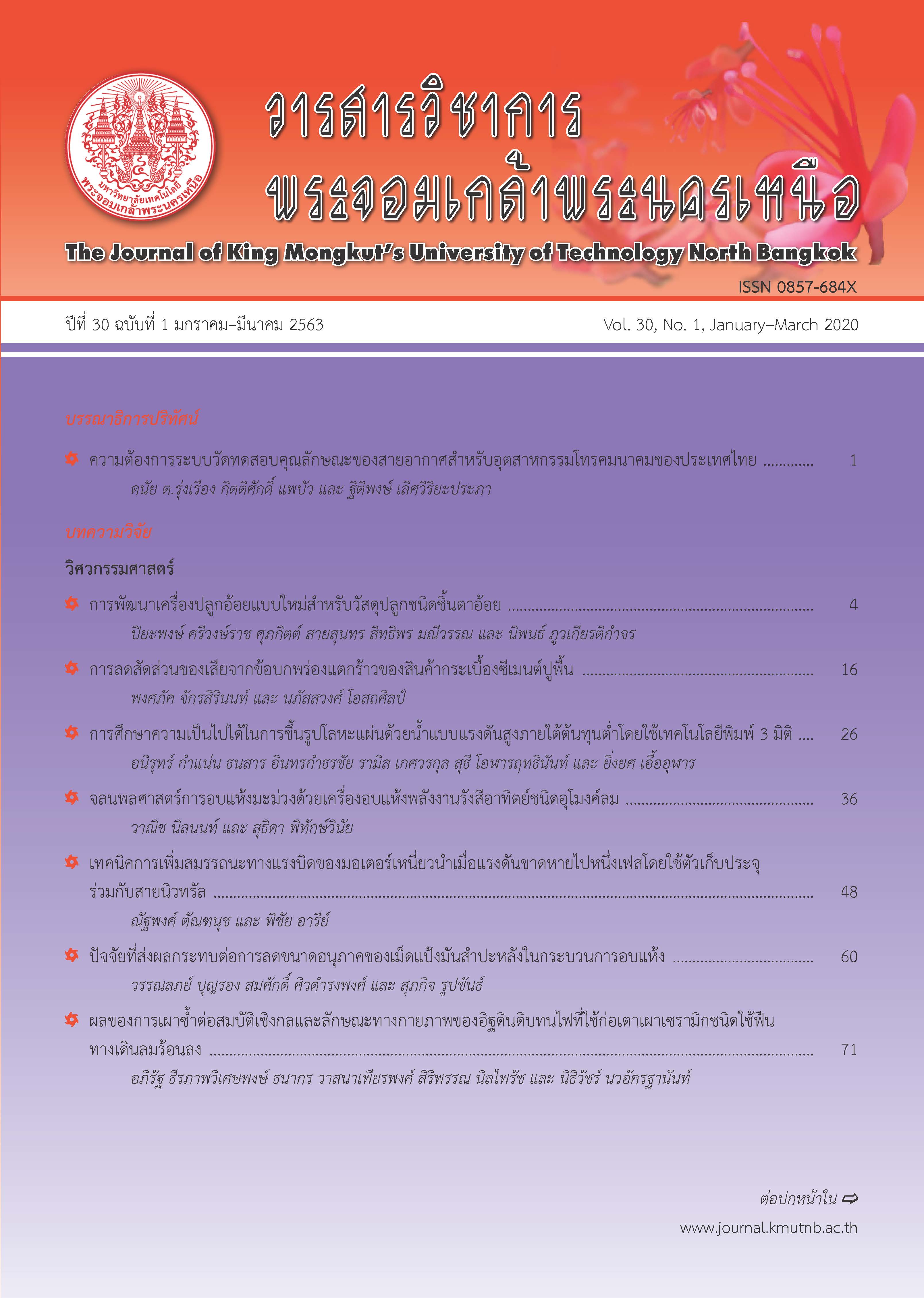Development of a Novel Sugar Cane Planter for Bud Chip as Planting Material
Main Article Content
Abstract
The objects of the present research are the development of a novel sugar cane planter for bud chip as planting material and analysis of engineering economics of the developed machine. Technically, the developed machine is operated with a 30-horsepower tractor and it is designed a 1-furrow planter. The main components of the machine consist of a furrow opener, a planting material-sending tube, the mainframe, a bucket conveyor, a planting material hopper, a fertilizer hopper, a fertilizer distributor, covering discs and a press wheel. Before operating the machine, practically, it is necessary to prepare a sugar cane bud chip by using a bud chip cutter developed by our research team. After that, the cut bud chip is loaded into a planting material hopper of the machine to be planted in the field by the machine. According to testing results by operating the machine with four different forward speeds, it was found that the machine was able to move and operate suitably at an operating speed of a 3th-low gear of a tractor. At this operating speed, the developed machine had a theoretical field capacity of 1.89 rai per hour, an effective field capacity of 1.25 rai per hour and a field efficiency of 66%. Regarding engineering economics analysis of the developed machine, it indicated that the cost of using the machine was equal to 192.9 Baht per hour. The break-even point and payback period were equal to 92.04 rai per year and 0.82 years, respectively.
Article Details
The articles published are the opinion of the author only. The author is responsible for any legal consequences. That may arise from that article.
References
[2] Foreign Agricultural Service. (2019, May). Sugar: World markets and trade. Department of Agriculture, United States [Online]. Available: https://apps.fas.usda.gov/psdonline/circulars/sugar.pdf
[3] Office of the Cane and Sugar Board. Sustainable Sugarcane field management. Office of the Cane and Sugar Board. Bangkok, Thailand [Online]. Available: https://www.ocsb.go.th/upload/journal/fileupload/144-4003.pdf
[4] B. S. Bahaloyodhin and S. Leeyavatananupong, “Development of sugarcane planter in Thailand,” KU Engineering Journal, vol. 5, pp. 136–135, 1988 (in Thai).
[5] B. Saitthiti, Tropical Farm Machinery. Bangkok: Department of Farm Mechanics, Faculty of Agriculture, Kasetsart University 2010 (in Thai).
[6] A. Patil, A. K. Dave, and R. N. S. Yadav, “Evaluation of sugarcane cutter planter,” Sugar Tech, vol. 6, no. 3, pp. 121–125, 2004.
[7] B. Tangwongkit, P. Piya-anat, and R. Tangwongkit, “Development of a sugarcane planter for soil and water conservation,” in Proceedings Kasetsart Conference 53th, 1997, pp. 516–523.
[8] A. M. Compagnon, C. E. A Furlani, R. P. Silva, M. T. Cassia, and F. H. Arriel, “Billet metering mechanism of a sugarcane planter,” African Journal of Agricultural Research, vol. 11, no. 38, pp. 3643–3650, 2016.
[9] K. Saengprachatanarug, C. Chaloemthoi, K. Kamwilaisak, P. Kasemsiri, S. C. Udom, and E. Taira, “Effect of metering device arrangement to discharge consistency of sugarcane billet planter,” Engineering in Agriculture, vol. 11, no. 3, pp. 139–144, 2018.
[10] K. Thammasiri, “Comparison of growth, yield, and yield components of three sugarcane varieties grown from bud chips and three-budded setts,” M.S. thesis, Department of Agronomy, Faculty of Agriculture, Kasetsart University, Bangkok, 1981 (in Thai).
[11] R. Jain, S. Solomon, A. K. Shrivastava, and A. Chandra, “Sugarcane bud chips: A promising seed material,” Sugar Tech, vol. 12, no. 1, pp. 67–69, 2010.
[12] Department of Agriculture Extension. (2013, August). Technique operation and maintenance in farm equipment. Ministry of Agriculture and Cooperatives. Bangkok, Thailand [Online]. Available: https://www.servicelink.doae.go.th/webpage/book_%2024%20guide/17.pdf
[13] RNAM Test Code & Procedures for Farm Machinery, Technical Series No. 12, 1983.
[14] P. Sriwongras, S. Intaravichai, and T. Kiatiwat, “Economic analysis of community level small rice mill,” The Journal of KMUTNB, vol. 29, no.2, pp. 237–246, 2019 (in Thai).
[15] S. Kumar, M. Singh, and B. R. Singh, “Feasibility and economic viability of raised bed planter in western plane zone of Uttar Pradesh, India,” Soil and Tillage Research, vol. 128, pp. 37–43, 2013.
[16] T. Thienyaem, K. Saengprachatanarug, N. Weerakulwattana, and S. Anutarapongpan, “Study of performance comparison between sugarcane billet planter and convection sugarcane planter in Khon Kaen province,” in Proceedings The 14th TSAE International Conference, 2013, pp. 259–261.
[17] D.N. Sharma and S. Mukesh, Farm Machinery Design, 2nd ed. India: Jain Brothers, 2010.
[18] C. Kusoncum and K. Sethanan, “A study of costs and returns of sugarcane production sent to the sugar mill for small-scale growers in Buakhao, Kuchinarai district, Kalasin province,” in Proceedings IE Network Conference, Phetchaburi Province, 2012, pp. 2134–2140.
[19] P. Manivong and E. Bourgois. (2017, February). Thai Sugarcane Sector and Sustainability. FairAgora Asia Co., Ltd. Bangkok, Thailand [Online]. Available: https://www.bonsucro.com/wp-content/uploads/2017/08/Thai-White-Paper-FINAL-LowRes.docx.pdf

